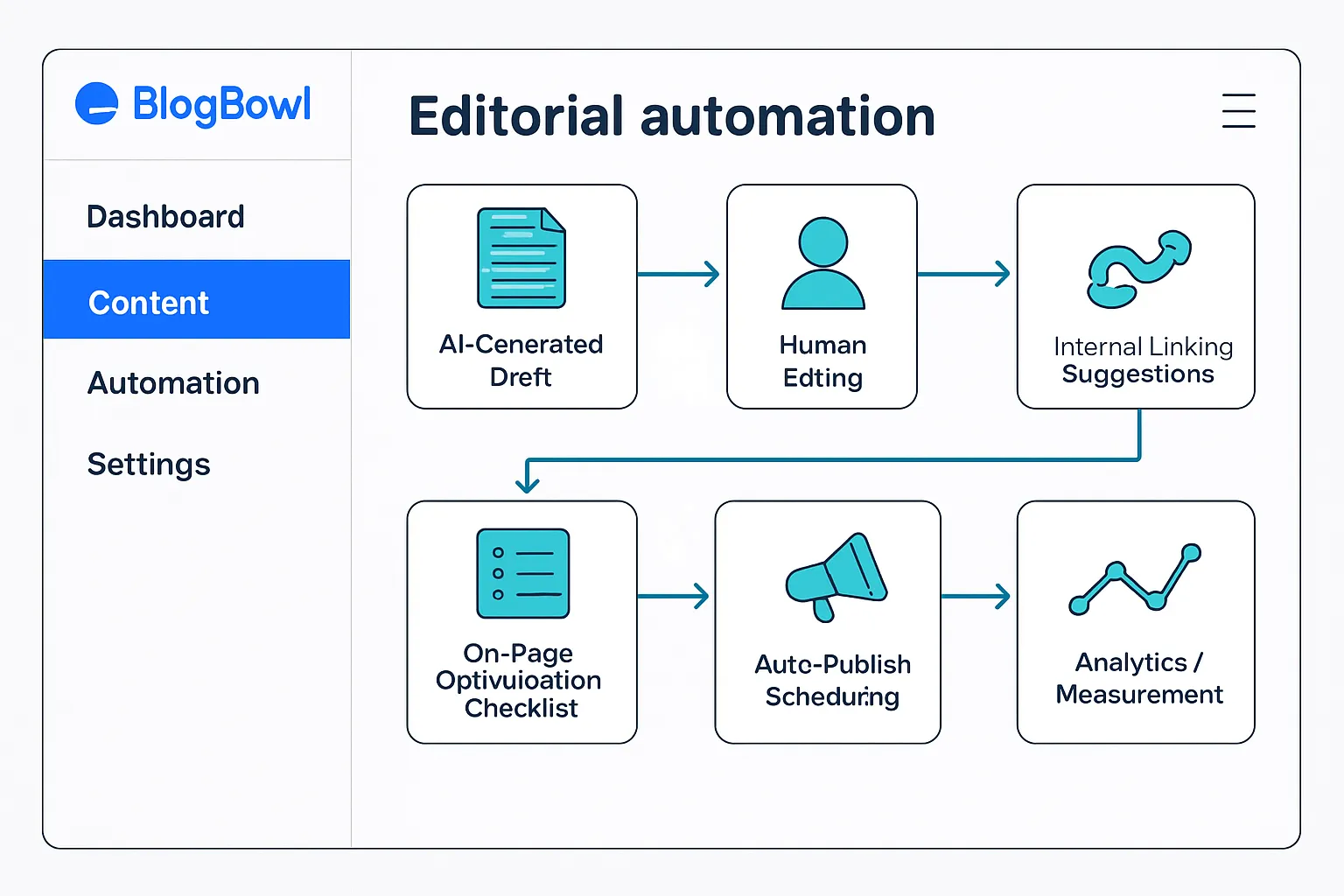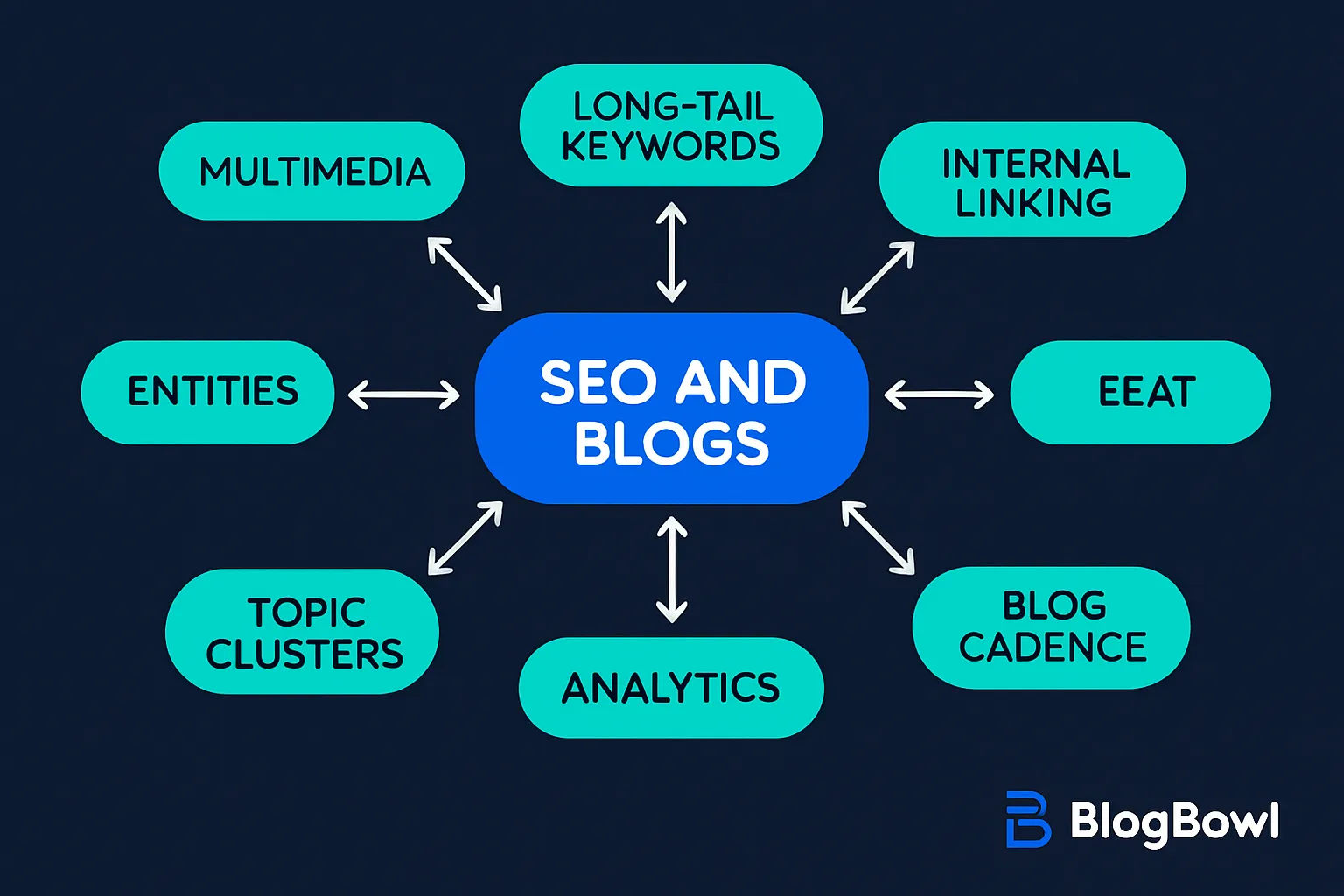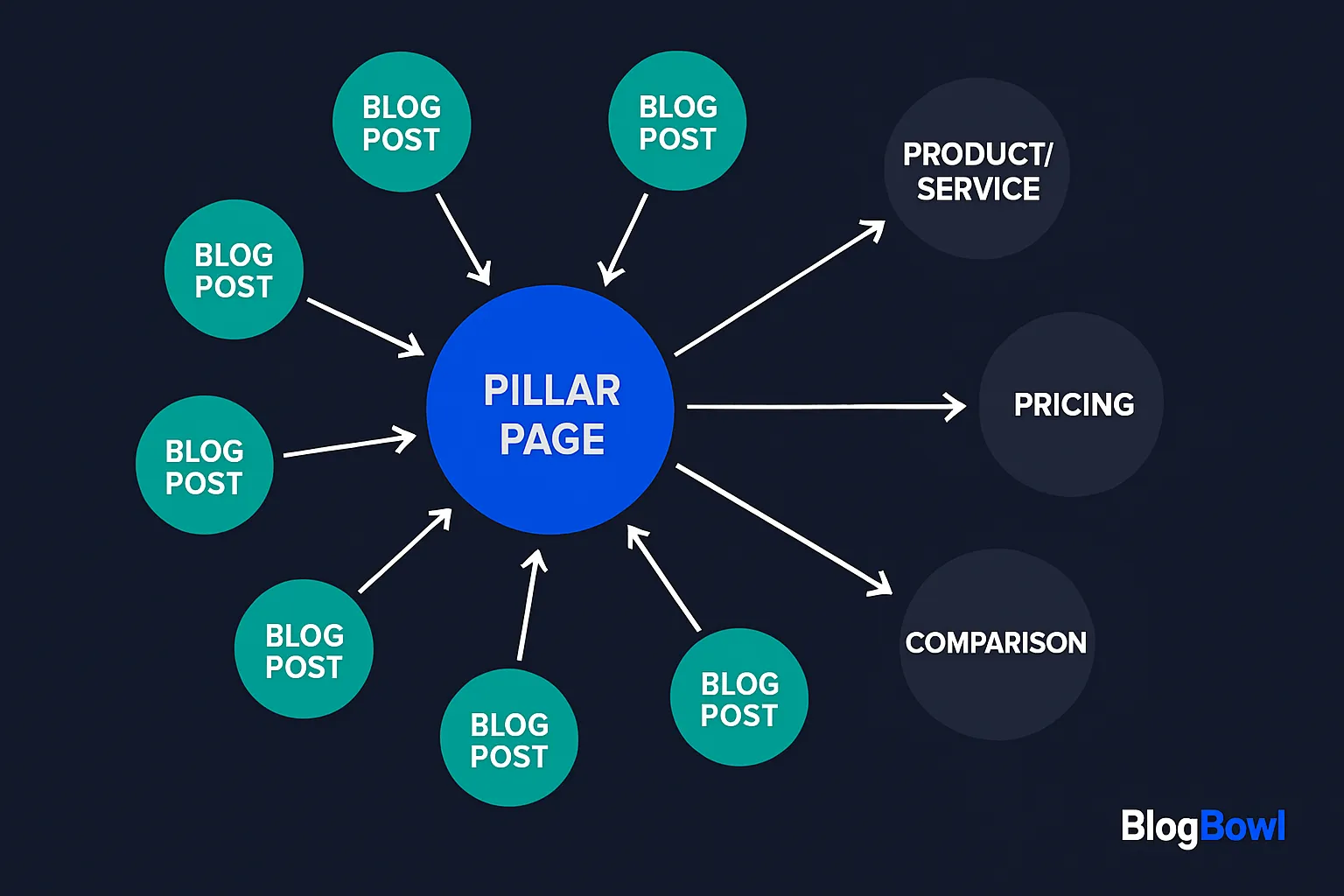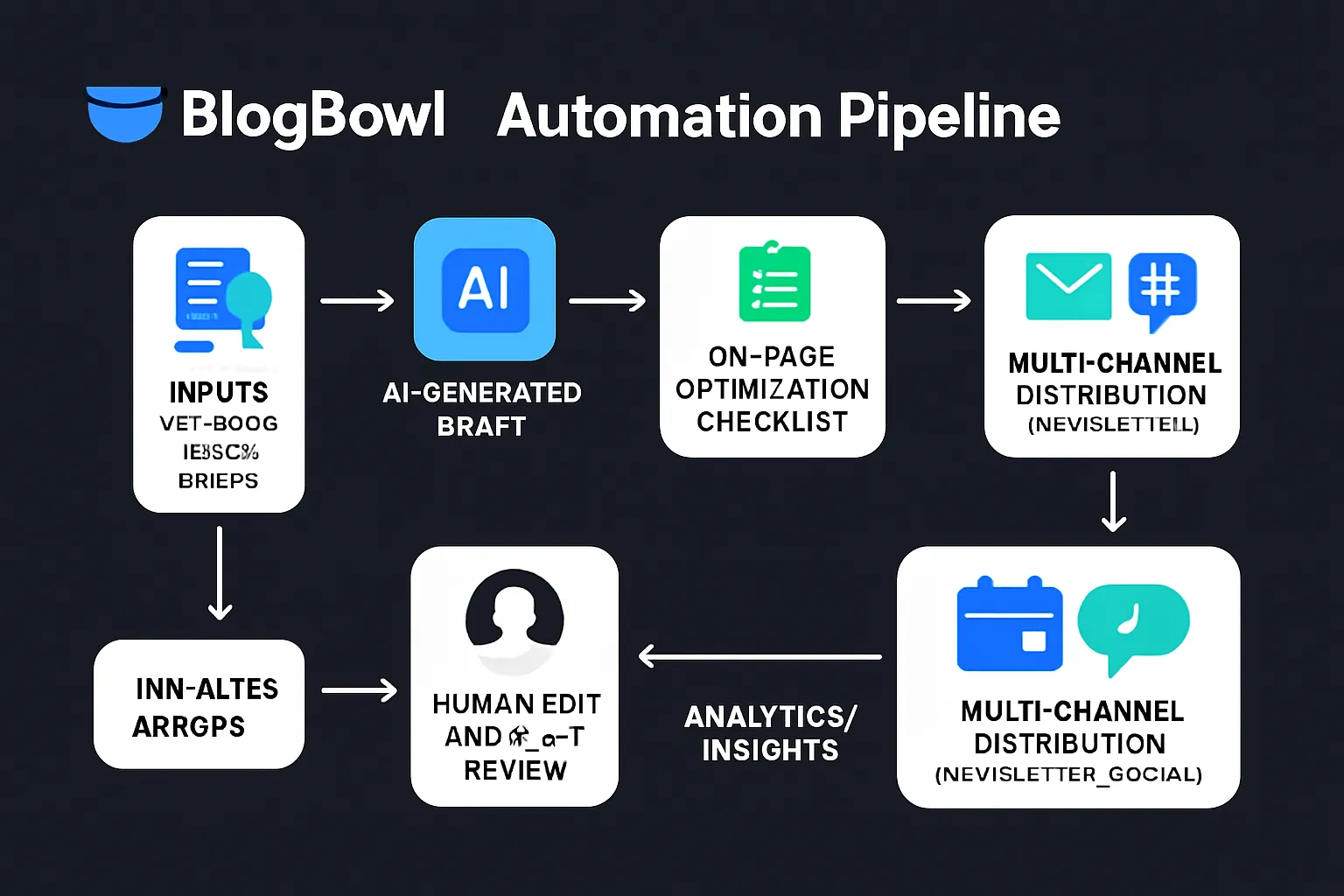SEO and Blogs: Why They’re Better Together
Search is how your best-fit customers discover you - and blogging is how you meet them with the answers they’re searching for. Put simply: SEO and blogs are two sides of the same growth engine. When you publish high-quality, optimized articles, you expand keyword coverage, earn backlinks, strengthen internal linking, and build topical authority. That’s how blog posts and SEO work together to drive compounding visibility, trust, and conversions.
"Companies that blog receive 55% more website visitors." - Source
Here’s why blogs help SEO:
Fresh, useful content signals relevance, helping you rank for more queries across the funnel.
Strategic internal links clarify site structure, distribute PageRank, and guide users toward conversion.
In-depth posts naturally attract backlinks and build E‑E‑A‑T, elevating domain authority over time.
What you’ll learn in this guide:
Strategy: How to plan topics that align with user intent and build topical authority
On-page optimization: Titles, meta descriptions, headers, images, and schema that win clicks
Internal linking: Structures that amplify rankings and move readers to product pages
Measurement: What to track (rankings, CTR, engagement, assisted conversions) and how to iterate
Scale with automation: How BlogBowl automates keyword research, daily SEO-optimized drafts, internal linking, and rich media so you can grow faster with less effort
At BlogBowl, we’ve built this playbook into our platform to help SaaS teams ship fast, rank faster, and convert readers into pipeline - without the manual grind. If you’ve ever wondered how to connect blog posts and SEO into a single growth loop, this guide will show you exactly how.
How Blogs Help SEO: The Ranking Signals You Influence
Freshness and indexation
Publishing new posts prompts more frequent crawling and keeps your site “alive” in Google’s eyes. Each fresh, indexable URL widens your keyword footprint and gives search engines more timely answers to rank - one of the core reasons blogs help SEO. Use consistent publishing to accelerate discovery, test new topics, and surface timely updates that product pages rarely cover.
"Google’s 2011 ‘freshness’ update impacted roughly 35% of searches, prioritizing more recent results." - Source
Long‑tail keywords and topical depth
Blog content lets you pursue specific, lower‑competition phrases that your core pages can’t accommodate. This long‑tail coverage captures intent across the funnel (how‑to, comparisons, troubleshooting), builds topical depth, and steadily compounds traffic - proof that aligning blog posts and SEO multiplies your discoverability.
Target variants and semantic questions that map to user intent.
Create series and clusters to deepen coverage and signal authority.
Update posts as queries evolve to preserve rankings and win new ones.
Internal linking and site architecture
Every new article is an internal‑linking opportunity. Use posts to distribute PageRank toward revenue pages, clarify topical relationships, and eliminate orphan pages that stall crawling.
Link up to pillar pages and down to related posts to reinforce clusters.
Add contextual links near the top third of the article to drive clicks.
Standardize anchor text so Google understands the destination’s purpose.
Engagement signals (CTR, dwell time)
Higher CTR and longer dwell time hint to search engines that your content satisfies intent. Clear headlines, scannable H2/H3s, short paragraphs, and embedded media reduce pogo‑sticking and keep readers engaged.
Front‑load value with descriptive titles and compelling meta descriptions.
Use bullets, tables, and visuals to speed comprehension.
Add relevant video, examples, and jump links to improve on‑page time.
EEAT and trust
Google rewards pages that demonstrate experience, expertise, authority, and trust. Your blog is the ideal place to showcase it.
Use real bylines, expert quotes, and contributor bios.
Cite trusted sources and include original insights, data, or screenshots.
Add clear sourcing and update logs to signal accuracy and recency.
When executed together, these practices prove why blogs help SEO: fresh content earns faster indexing, long‑tail coverage expands reach, internal links strengthen architecture, engagement improves behavioral signals, and strong EEAT builds trust - turning blog posts and SEO into a compounding growth loop.
Blog SEO Strategy 2025: From Keywords to Cadence
"56% of consumers have made a purchase after reading a blog post." - Source
Define goals and KPIs
Tie your blog plan to revenue with clear outcomes and diagnostics:
Traffic and rankings distribution across core topics and long‑tails
Assisted conversions (demo requests, free trials, pipeline attribution)
Newsletter signups and content downloads
Engagement (CTR, dwell time, return visitors) and content velocity
Technical health (indexation, Core Web Vitals) and link growth
Build a content moat with topic clusters
Own a category by covering it comprehensively:
Create a pillar page that answers the overarching problem end‑to‑end.
Publish supporting posts for subtopics, questions, comparisons, and how‑tos.
Interlink pillar ↔ cluster posts with consistent, descriptive anchors.
Refresh clusters quarterly to protect rankings and expand topical depth.
Choose a publishing cadence you can sustain
Consistency compounds. Pick a cadence you can maintain at quality:
Weekly or bi‑weekly for lean teams; multi‑weekly if you have scale.
Batch research, briefs, and drafts; schedule publication in advance.
Maintain a 60–90‑day calendar with buffer slots for timely updates.
Workflow that wins
Research → brief → draft → on‑page optimize → internal links → publish → promote → update
Research: Map intent, keywords, and SERP features; outline search questions.
Brief: Set H2s/H3s, target terms, internal links, and sources.
Draft: Prioritize clarity, originality, and examples/screenshots.
On‑page: Optimize title, meta, headers, images/alt text, and schema.
Internal links: Add contextual links to pillars, products, and related posts.
Publish: Validate technical checks (canonical, indexability, speed).
Promote: Newsletter, social, partners, communities; repurpose into clips.
Update: Revisit at 30/90 days; improve sections, add data, expand FAQs.
Blog SEO Funnel Map
Funnel Stage | Blog Formats | Example Topics | Primary KPI |
|---|---|---|---|
Awareness | Guides, checklists, definitions, industry trends | “What is internal linking?”, “SaaS SEO checklist 2025”, “AI content pitfalls” | Organic sessions, new users |
Consideration | Comparisons, alternatives, frameworks, case studies | “Topic clusters vs. single posts”, “Best blog CMS for startups”, “Internal linking strategies” | Rankings for intent terms, newsletter signups |
Decision | ROI explainers, implementation playbooks, customer stories | “How BlogBowl automates internal linking”, “SEO content ops template”, “From 0→50K organic in 6 months” | Trials/demos, assisted conversions |
Leverage BlogBowl to automate the heavy lifting
Scale quality without burning your team:
Daily AI drafts tuned to your strategy and tone
Keyword pipeline and gap analysis with prioritization
Automatic internal linking across pillars and clusters
Smart media embeds (unique AI images, contextual videos)
Built‑in analytics and content velocity tracking
Automatic backlink exchange to accelerate authority growth

Stay focused on strategy and narrative - let BlogBowl handle the repetitive SEO/content ops so you can publish consistently, measure what matters, and grow faster.
Keyword Research for Blog Posts: Topic Clusters, Entities, and Long‑Tail Wins
Start with search intent
Search intent should drive every keyword decision for your seo blog. Before drafting, analyze the SERP:
Informational: Guides, definitions, tutorials, “how to do seo for my blog,” PAA boxes, and featured snippets.
Commercial: Comparisons, “best,” “vs,” “alternatives,” listicles, and review snippets.
Transactional: Pricing pages, templates, calculators, and strong CTAs.
Scan the top 10 results, People‑Also‑Ask, and Related Searches. Note content formats, depth, and subtopics. If the SERP is dominated by in‑depth guides and FAQs, plan a comprehensive article; if it’s comparison‑heavy, craft a commercial piece instead. Aligning the angle with intent increases your odds of winning the snippet and the click.
Build clusters around entities
Think beyond keywords - map the entities (concepts, brands, features, frameworks) that define your topic. For “SEO and Blogs,” key entities include internal linking, EEAT, topic clusters, long‑tail keywords, schema, page speed, and analytics. Expand with:
Synonyms and variants: “blog SEO,” “seo blog,” “blog search optimization,” “seo for my blog.”
User questions: Mine People‑Also‑Ask and Related Searches to fill gaps in your cluster.
Relationships: Show how concepts connect (e.g., internal linking → PageRank flow → pillar pages).
Use this entity map to plan your pillar and supporting posts, then interlink systematically so Google understands topical breadth and depth.

Long‑tail targeting for faster wins
Long‑tails are your quickest path to rankings and revenue because they:
Face lower competition and map tightly to intent.
Convert better (specific problems, solution‑seeking readers).
Help you earn topical authority that lifts broader terms later.
Balance difficulty and volume. Prioritize “easy‑to‑win” phrases with clear intent and add semantic variants within the same post. Use internal links to channel visitors from long‑tail articles to your pillar and product pages.
Tools and prompts
Let BlogBowl do the heavy lifting:
Automated keyword research: Generates clusters, entities, and outlines from your seed topics.
Smart briefs: Inserts SERP analysis, target questions, and internal link recommendations.
Internal linking: Auto‑suggests links across your cluster and product pages.
One‑click embeds: Adds images, videos, and tables to improve on‑page experience.
Prompts you can use today:
“Generate 25 long‑tail topics for seo for my blog focused on internal linking and topic clusters.”
“Map entities, synonyms, and FAQs for a pillar on SEO and Blogs with three cluster levels.”
“Draft a brief for ‘on‑page SEO checklist for a seo blog’ including PAA questions and internal link anchors.”
Topic Cluster Blueprint (SaaS Example)
Pillar Topic | Cluster Post Idea | Target Long‑Tail Keyword | Search Intent | Internal Link Targets |
|---|---|---|---|---|
SEO and Blogs | Internal Linking Strategies for SaaS Blogs | internal linking for blog seo | Informational | Pillar: SEO and Blogs; Product: BlogBowl Internal Linking; Case Study |
SEO and Blogs | How to Build Topic Clusters for a seo blog | topic clusters seo blog | Informational | Pillar; Template Library; Features: Keyword Research |
SEO and Blogs | EEAT for SaaS Content: Examples and Checklists | eeat for saas blog | Informational | Pillar; Author Bio Guidelines; Trust Signals Page |
SEO and Blogs | Long‑Tail Keyword Research for B2B SaaS | long tail keywords for b2b saas | Informational | Pillar; Features: Keyword Pipeline; Demo |
SEO and Blogs | On‑Page SEO Checklist for Blog Posts | on-page seo for my blog checklist | Informational | Pillar; Optimization Checklist; Help Docs |
SEO and Blogs | Blog Publishing Cadence for Startups | blog publishing cadence seo | Informational | Pillar; Editorial Calendar; Analytics |
SEO and Blogs | Blog SEO Analytics: What to Track and Why | blog seo analytics dashboard | Informational/Commercial | Pillar; Features: Analytics; Changelog |
SEO and Blogs | AI + Human Editing: A Workflow That Ranks | ai blog writing workflow saas | Informational/Commercial | Pillar; Features: AI Drafts; Free Trial |
Use this blueprint as your operating system: target intent, cover entities comprehensively, go after long‑tails for traction, and let BlogBowl automate cluster research, briefs, and internal links so your team can focus on expert insights and quality execution.
On‑Page Optimization Checklist for Every SEO Blog Post (SEO for my blog)
Title tags that earn clicks
Lead with the primary keyword and promise a clear benefit.
Keep to 55–60 characters to avoid truncation (optimize for pixels, not just characters).
Use emotional/power modifiers where natural (e.g., “fast,” “proven,” “step‑by‑step”).
Match search intent; if the SERP is list‑heavy, consider adding a number.
Example: “SEO for My Blog: 12 Proven Steps to Rank Faster”
Meta descriptions that set expectations
Aim for 140–160 characters; write for humans first.
Structure: benefit + keyword + CTA (e.g., “Learn how SEO for my blog drives organic growth - use our checklist to rank faster. Get the template.”).
Reflect the post’s exact value to improve CTR and reduce pogo‑sticking.
Avoid duplicate descriptions across posts.
URL slugs
Short, descriptive, and keyword aligned (e.g., /seo-and-blogs, /seo-for-my-blog-checklist).
Use lowercase, hyphens, and remove stop words and dates.
Don’t change slugs post‑publish; if you must, 301‑redirect and update internal links.
Heading hierarchy (H1–H3) and scannability
One H1 only, mirroring or closely matching the title.
Descriptive H2s that map to key subtopics; H3s for subsections.
Use short paragraphs (1–3 sentences), bullet lists, and bold callouts for skim‑readers.
Insert jump links for longer guides to improve UX and dwell time.
Image optimization
Use descriptive filenames (e.g., blog-seo-checklist.png vs. IMG_001.png).
Compress assets (target <250KB per image where possible) and set correct dimensions.
Write unique, contextual alt text that supports the surrounding copy and intent.
Prefer original images/diagrams; include captions if they add clarity.
Structured data
Add Article or BlogPosting schema: headline, author, datePublished, dateModified, image, publisher.
Use FAQ schema for concise Q&A sections to target rich results.
Validate with Google’s Rich Results Test before publishing.
Links
Add 2–4 internal links to pillars, related cluster posts, and key product/feature pages.
Use natural, descriptive anchor text (avoid “click here”).
Include 1–3 authoritative external citations to support claims and enhance EEAT.
Check for broken links; ensure no orphaned post (at least one internal inbound link).
Above‑the‑fold summary
Provide a 2–3 sentence TL;DR that answers the primary query immediately.
Include the primary keyword once, a key benefit, and who the post is for.
Keep it human; this also helps LLMs summarize your content accurately.
Bonus quality signals to lock in rankings
Add a clear byline, expert credentials, and an updated date (dateModified).
Include a short “How we researched” note if you rely on data or experiments.
Ensure canonical tag is correct; avoid duplicate title/meta across similar posts.
Pass Core Web Vitals (especially LCP/CLS) to protect rankings.
Tip: BlogBowl can auto‑suggest internal links, generate optimized meta data, embed unique images, and keep an editorial checklist visible during drafting so every seo blog post ships fully optimized - consistently.
Internal Linking Architecture: Turn Blog Posts into an SEO Flywheel
From posts to money pages
Turn every post into a strategic bridge to revenue:
Add contextual links from supporting articles to service/product, pricing, and “compare” pages using descriptive anchors (e.g., “SEO blog automation platform” vs. “click here”).
Place at least one commercial‑intent link in the first third of the article; add a second within a “What’s next” or “Implementation” section.
Use comparison and case‑study posts to funnel qualified visitors to demo/trial and pricing pages.
Create mini‑CTAs near relevant paragraphs to improve CTR without disrupting reading flow.
Silo your topics without creating dead ends
Build scalable hubs that spread PageRank and keep readers exploring:
Organize clusters: pillar (hub) → supporting posts → deeper how‑tos/FAQs. Always link up to the pillar and sideways to related posts.
Add “Related reads” modules and in‑line contextual links to eliminate orphaned content.
Standardize anchors that reflect the destination’s topic (e.g., “topic cluster strategy” for your pillar, “on‑page SEO checklist” for tactical guides).
Ensure every new post has at least one internal inbound link from an indexed page and one outbound link to a pillar or product page.
Scale with automation
Ship links at scale without sacrificing relevance:
BlogBowl auto‑suggests contextually relevant links at publish time based on your clusters and priority pages.
Configure priority targets (pricing, product, comparison, and feature pages) so new posts continually feed your funnel.
Automatically update legacy posts with fresh internal links when new, related content goes live.

Quality Signals: E‑E‑A‑T, Readability, and Accessibility in Blog SEO
Demonstrate expertise and experience
Show real‑world competence so readers and search engines can trust your work:
Add author bios with credentials, roles, and links to professional profiles.
Reference hands‑on experience: case studies, postmortems, teardown screenshots.
Publish first‑party data and original visuals (charts, annotated screenshots).
Include review processes (editorial sign‑off, SME review) for technical posts.
Cite and update
Keep your content accurate and current:
Link to authoritative sources (official docs, standards bodies, academic or established industry publishers).
Add an “Updated on” date and change log; note significant revisions.
Refresh time‑sensitive sections (stats, UI changes, pricing, SERP features) on a set cadence.
Use consistent citation formatting and link to the primary/original source when possible.
"Of these aspects, trust is most important. The others contribute to trust, but content doesn't necessarily have to demonstrate all of them." - Source
Readability and accessibility
Make posts effortless to consume for everyone:
Use plain language, short sentences, and logical subheads; prefer active voice.
Break up text with lists, pull‑quotes, and tables; keep paragraphs to 1–3 sentences.
Write descriptive alt text, add captions for complex visuals, and include transcripts for audio/video.
Maintain sufficient color contrast, accessible link text, and keyboard‑friendly navigation.
Trust elements
Eliminate friction and demonstrate care for users:
Publish clear editorial standards and correction policies.
Use privacy‑friendly analytics and honor user consent; minimize tracking.
Avoid intrusive interstitials and auto‑playing media; keep ads clearly labeled and sparse.
Display contact details, company information, and secure site indicators (HTTPS) to reinforce legitimacy.
These quality signals compound over time - elevating your E‑E‑A‑T, improving engagement, and helping your blog content win and retain competitive positions in search.
Scale What Works: Repurposing, Content Updates, and Automation with BlogBowl
Historical optimization
Protect and grow compounding traffic by updating winners and rescuing decaying posts:
Identify content decay (rank drops, CTR dips, declining sessions over 60–90 days).
Refresh stats and screenshots, expand thin sections, and tighten the match to current intent.
Add missing subtopics from PAA/related searches; improve title/meta for higher CTR.
Update internal links (both inbound and outbound) and add an “Updated on” note.
Consolidate and redirect
Cut noise and consolidate equity:
Merge overlapping or thin posts into a single, comprehensive resource.
Keep the strongest URL live; 301‑redirect weaker pieces and update internal links.
Preserve and repurpose unique angles (tables, examples, visuals) within the consolidated post.
Validate canonicals and track ranking transfer over 2–4 weeks.
Repurpose for reach
Multiply distribution without rewriting from scratch:
Turn posts into social carousels, X/LinkedIn threads, short videos, and webinar outlines.
Spin key sections into newsletter issues; link back to the canonical article.
Package related posts into downloadable checklists or templates to capture emails.
Clip quotes, charts, and briefs for community posts and partner roundups.
Automate the pipeline with BlogBowl
Scale output while maintaining quality:
Daily AI‑generated drafts aligned to your strategy and tone
Keyword queue and gap analysis to keep your calendar full
Automatic internal linking across pillars, clusters, and product pages
Unique AI images and contextual embedded videos added on publish
Multi‑blog, multi‑channel automatic publishing and promotion
Built‑in analytics and an optimization loop to prioritize the next update

Measure and Improve: SEO Metrics and Dashboards for Your Blog
Traffic and visibility
Benchmark how discoverable your content is in search and what earns the click.
Organic sessions: Trend by week/month; segment by landing page, cluster, country, device.
Impressions: Gauge potential demand; use rising impressions + flat clicks to find CTR wins.
Average position: Track by query and cluster; watch for volatility after updates.
CTR by query: Pair titles/meta to intent; test new headlines for queries with low CTR vs. position.
What to add to your dashboard:
Top queries by impressions, clicks, CTR, position (with filters for brand vs. non‑brand).
Landing pages with the highest delta in impressions or position (leading indicators for growth).
Device split (mobile/desktop) to surface snippet and UX opportunities.
Content performance
Measure how well each article satisfies intent and contributes to pipeline.
Time on page and engaged time: Spot underperformers; improve intros, structure, and examples.
Scroll depth: Use 25/50/75/100% markers to find drop‑off sections; tighten or re‑order content.
Exit rate: High exits from mid‑funnel posts can signal weak internal links or misaligned intent.
Assisted conversions: Attribute newsletter signups, trials/demos, and form fills touched by blog posts.
Path analysis: Identify common journeys from long‑tails → pillar → product/pricing.
Dashboard modules:
Post‑level engagement table (time on page, scroll, exits, bounce).
Conversion contributions (last touch vs. assisted) by post and cluster.
“Next‑click” analysis: Top internal links clicked from each article.
Rankings distribution and share of voice
Watch your footprint grow within topics you care about.
Coverage: Count pages/keywords in top‑3, top‑10, top‑20 for each cluster.
Share of voice (SoV): Your clicks ÷ total clicks for tracked keywords (or impression share proxy).
Competitor gaps: Who owns the SERP features (featured snippets, People‑Also‑Ask, image packs)?
Feature presence: Track wins/losses for snippets, FAQs, sitelinks; adjust structure accordingly.
Operational views:
Cluster heatmap: Keywords by rank bucket (1–3, 4–10, 11–20, 21–50).
Competitor leaderboard: Clicks, CTR, and snippet holders per topic.
Opportunity list: Keywords within striking distance (positions 4–12) to prioritize updates.
Content decay alerts and refresh cadence
Stay ahead of declines and protect compounding traffic.
Decay rules: Trigger alerts when any of the following fall >20% over a 28‑day period vs. prior period:
Clicks or sessions
CTR (with stable impressions)
Average position (drops ≥2 spots)
Refresh cadence:
Evergreen pillars: Review quarterly; update data and examples.
Long‑tails: Review every 4–6 months or when SERP intent shifts.
Product‑adjacent posts: Review after product launches/price changes.
Update playbook: Tighten intros, add missing subtopics (from PAA/Related), improve visuals/alt text, re‑map internal links, re‑submit for indexing, annotate changes.
Toolstack
The essentials to build reliable, privacy‑friendly reporting.
Google Search Console: Queries, CTR, position, page‑query diagnostics, manual indexing requests.
GA4: Landing‑page engagement, scrolls, events, and assisted conversion paths.
BlogBowl analytics:
Privacy‑friendly page analytics and newsletter metrics (opens, CTR, subscriber growth).
Cluster‑level dashboards (rank coverage, content velocity, SoV proxy).
Content decay alerts and “striking distance” recommendations.
Automatic internal‑link impact tracking and backlink exchange insights.
Pro tip: Add clear owners and SLAs to your dashboard. For every metric panel (e.g., “Top pages with CTR <2% in positions 3–8”), define the action (rewrite title/meta), due date, and assignee. Momentum - not perfect data - is what compounds results.
Conclusion: Launch an SEO‑Ready Blog in Minutes with BlogBowl
Great SEO and blogs compound together: publishing fresh, useful articles speeds indexation, long‑tail coverage expands your keyword footprint, smart internal linking strengthens your site architecture, and consistent quality builds E‑E‑A‑T and trust. Do this repeatedly and rankings, traffic, and conversions snowball.
Why BlogBowl
Launch in under 60 seconds - no code, no plugins, no maintenance
AI‑powered daily SEO content aligned to your strategy and tone
Automatic keyword research and internal linking across pillars and clusters
Unique AI images and contextual embedded videos added at publish
Integrated newsletter and privacy‑friendly analytics in one place
Automatic backlink exchange to accelerate authority growth
Next step: Start your SEO blog today at https://www.blogbowl.io and grow traffic and authority on autopilot.


